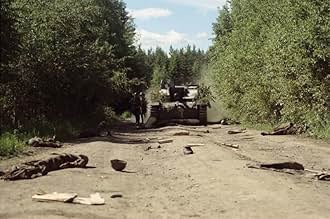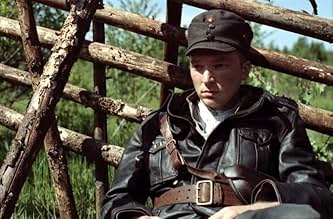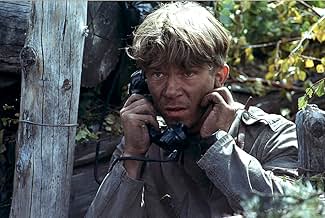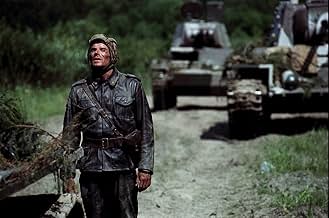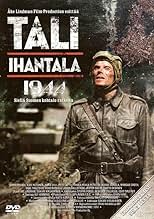Ajouter une intrigue dans votre langueIn the summer of 1944, the Finnish Forces must defend Finland from the invading Soviet Red Army.In the summer of 1944, the Finnish Forces must defend Finland from the invading Soviet Red Army.In the summer of 1944, the Finnish Forces must defend Finland from the invading Soviet Red Army.
- Réalisation
- Scénario
- Casting principal
- Récompenses
- 4 nominations au total
Avis à la une
Like I said in the discussion-threads about this movie: this a documentary masquerading as a movie. There's zero character-development and "drama". What we have instead is warfare. No BS, just warfare. If you expect good characters and all the other things you could find in other movies, this is not a movies for you. But if you are interested in warfare, then this movie delivers.
And to comment on the review by Mr. Stensson from Sweden: Continuation War is in fact _widely_ discussed in Finland :). And fighting alongside Germans was realistically speaking the only choice. Allying with the West was not possible, since Germany occupied Norway. Allying with Sweden was attempted, but Soviets would not allow it. Allying with Soviets was not an option, since they kept on harassing Finland after the war, and it was thought that they would resume hostilities sooner or later. And I would say that the West made a deal with the devil as well. In many ways the Stalinist USSR was just as bad as Nazi-Germany was.
Like it's name says, Continuation War was a direct continuation of Winter War. Had Winter War not happened, there would not have been Continuation War. And we all know who started the Winter War....
Finns never attempted to attack Leningrad, and they in fact voluntarily stopped at the old border in the Karelian Isthmus (well, they straightened the front by going over the border in the middle, but that's about it). Had they wanted to, they could have taken Leningrad, since Soviets had moved most of their troops against the Germans.
I would like to know what we _should_ have done instead? And in any case: hindsight is always 20/20. What all this has to do with the qualities of this particular movie is beyond me... If you want to further discuss this topic, my advice is to head to the discussion-forum.
And to comment on the review by Mr. Stensson from Sweden: Continuation War is in fact _widely_ discussed in Finland :). And fighting alongside Germans was realistically speaking the only choice. Allying with the West was not possible, since Germany occupied Norway. Allying with Sweden was attempted, but Soviets would not allow it. Allying with Soviets was not an option, since they kept on harassing Finland after the war, and it was thought that they would resume hostilities sooner or later. And I would say that the West made a deal with the devil as well. In many ways the Stalinist USSR was just as bad as Nazi-Germany was.
Like it's name says, Continuation War was a direct continuation of Winter War. Had Winter War not happened, there would not have been Continuation War. And we all know who started the Winter War....
Finns never attempted to attack Leningrad, and they in fact voluntarily stopped at the old border in the Karelian Isthmus (well, they straightened the front by going over the border in the middle, but that's about it). Had they wanted to, they could have taken Leningrad, since Soviets had moved most of their troops against the Germans.
I would like to know what we _should_ have done instead? And in any case: hindsight is always 20/20. What all this has to do with the qualities of this particular movie is beyond me... If you want to further discuss this topic, my advice is to head to the discussion-forum.
First of all, I have to say that I had huge expectations about the movie. I went to theater to see some mind-blowing action. I was hoping that Åke Lindman had made something spectacular as his last movie. I also believed in his directing talents. Now I sadly have to say that the movie didn't fulfill my expectations.
The movie was a bit bouncing: Going there, doing that, coming back and going again. Different people fought in different places and sometimes it was hard to follow what was happening as a whole. Well this wasn't too disturbing as the movie still was entertaining. Especially all tank-scenes were amazing. The lack of money, which was clearly visible, was maybe the most disruptive thing in the movie. As mentioned in the movie, there were about 250 cannons and mortars, plus bomber planes, targeting the Tali-Ihantala area. But when the "big fight" came, it looked like about 10 guns were bombing the woods with smoke grenades (And I can say this because I have served in mortar company in the Finnish army). I'm sure it looked like that because there were not enough money to make it look realistic. I was also hoping more soldiers running in the woods because hey, it was supposed to be the biggest fight in the northern Europe!
Now the rating of the movie. I was balancing between 6 and 7. I would have wanted to give it 7 points, but as I was thinking it, the movie actually left me disappointed. It wasn't as astonishing as I wanted. It was just another Finnish war movie, and even Tuntematon sotilas from the year 1955 and especially The Winter war from 1989 are much better movies than this one.
So, should you go to watch Tali-Ihantala? a) Finnish movie business needs your money, so YES! b) If you like Finnish war movies, definitely yes. But if you decide to go watch it, don't have too big expectations so you won't be disappointed.
P.S. Not a single mortar was shown during the movie. Why? Glad they mentioned them though ;)
The movie was a bit bouncing: Going there, doing that, coming back and going again. Different people fought in different places and sometimes it was hard to follow what was happening as a whole. Well this wasn't too disturbing as the movie still was entertaining. Especially all tank-scenes were amazing. The lack of money, which was clearly visible, was maybe the most disruptive thing in the movie. As mentioned in the movie, there were about 250 cannons and mortars, plus bomber planes, targeting the Tali-Ihantala area. But when the "big fight" came, it looked like about 10 guns were bombing the woods with smoke grenades (And I can say this because I have served in mortar company in the Finnish army). I'm sure it looked like that because there were not enough money to make it look realistic. I was also hoping more soldiers running in the woods because hey, it was supposed to be the biggest fight in the northern Europe!
Now the rating of the movie. I was balancing between 6 and 7. I would have wanted to give it 7 points, but as I was thinking it, the movie actually left me disappointed. It wasn't as astonishing as I wanted. It was just another Finnish war movie, and even Tuntematon sotilas from the year 1955 and especially The Winter war from 1989 are much better movies than this one.
So, should you go to watch Tali-Ihantala? a) Finnish movie business needs your money, so YES! b) If you like Finnish war movies, definitely yes. But if you decide to go watch it, don't have too big expectations so you won't be disappointed.
P.S. Not a single mortar was shown during the movie. Why? Glad they mentioned them though ;)
I really don't understand why this movie does not rate much, much more highly. It seems that Finns are the harshest critics. While they may have their reasons, for a wider audience I can't think of many better films on WW2. (I am Australian btw).
This is a detailed, gripping retelling of a little known war. The attention to detail is outstanding, whether it is the tanks, the scenes, the positions or the thinking behind it all. For a minor language film (sorry Finns but it is the case) it is particularly lavish in quality, scope & depth.
No, it is not a character drama. To be honest, the characters are only to hold the wider story together. If character drama is what you are after, look elsewhere or be disappointed. That is NOT what Tali- Inhatala is all about. I get the feeling that this movie was intended to be a statement for history & future generations - "this is what happened & how". It succeeds remarkably well in achieving this.
A superb movie & historical record. Very, very highly recommended.
This is a detailed, gripping retelling of a little known war. The attention to detail is outstanding, whether it is the tanks, the scenes, the positions or the thinking behind it all. For a minor language film (sorry Finns but it is the case) it is particularly lavish in quality, scope & depth.
No, it is not a character drama. To be honest, the characters are only to hold the wider story together. If character drama is what you are after, look elsewhere or be disappointed. That is NOT what Tali- Inhatala is all about. I get the feeling that this movie was intended to be a statement for history & future generations - "this is what happened & how". It succeeds remarkably well in achieving this.
A superb movie & historical record. Very, very highly recommended.
Being Finnish, it is often difficult to comment on Finnish war movies. Since most Finns have at least an elementary grasp of the timeline and locations of the events, you can understand better what is happening in front of you. This creates a situation where these movies become difficult to follow for other audiences and that's where they usually go wrong.
Let's look at the good sides first. The fact that they actually acquired proper vehicles instead of using CGI was a huge upside. The costumes, the equipment looked pretty good. The inside shots of the vehicles were good. However, all of these upsides were not enough to cover up for the confusing direction and weak screenplay. Yes, I said it, the cat is out of the bag.
The premise is good, and if the director had chosen to go the route of "A Bridge too Far" or "The Longest Day", this movie would have been much better. The greatest flaws were the lack of character development, sense of urgency from the fighting and overall confusion of what was actually happening. These were so bad that you don't even notice the horrible dialogue.
Both of the Hollywood movies I mentioned spent the first hour with character development, and the remainder showing those characters whom you had now developed a connection to, in situations where you as the viewer felt that they were in immediate danger. In T-I, there were no scenes that had the same feeling like Robert Redford paddling across the Nijmegen or the "cricket" scene from TLD.
When shooting a large scale epic like this, the HQ scenes must act as the glue that holds all of the action together and keeps the viewer in the loop for whats actually happening. Instead of the overview maps, I would have preferred to see a mapboard and commanders discussing the situation. Now you just see almost identical maps and it seems like the Russians are not doing anything, and the Finns are mounting some kind of counterattacks somewhere for no particular reason. You can see that around 90 minutes (the radio intelligence scene) they did attempt this for a few minutes, which ended up being the most enjoyable part of the movie. Too bad that the action that unfolded ended up being so anticlimactic.
I really wanted to like this movie, but I felt very disappointed with it in the end. Also, the English subtitles had some annoying missteps evident in too many Finnish DVD productions; incorrect terminology and desperate attempt to make Finns speak UK English, whereas Finns in my experience speak more like Americans with their colorful expressions.
Recommended only for hard core WW2 vehicle buffs. I suggest "Ambush" if you're looking for an actually entertaining movie about this subject.
Let's look at the good sides first. The fact that they actually acquired proper vehicles instead of using CGI was a huge upside. The costumes, the equipment looked pretty good. The inside shots of the vehicles were good. However, all of these upsides were not enough to cover up for the confusing direction and weak screenplay. Yes, I said it, the cat is out of the bag.
The premise is good, and if the director had chosen to go the route of "A Bridge too Far" or "The Longest Day", this movie would have been much better. The greatest flaws were the lack of character development, sense of urgency from the fighting and overall confusion of what was actually happening. These were so bad that you don't even notice the horrible dialogue.
Both of the Hollywood movies I mentioned spent the first hour with character development, and the remainder showing those characters whom you had now developed a connection to, in situations where you as the viewer felt that they were in immediate danger. In T-I, there were no scenes that had the same feeling like Robert Redford paddling across the Nijmegen or the "cricket" scene from TLD.
When shooting a large scale epic like this, the HQ scenes must act as the glue that holds all of the action together and keeps the viewer in the loop for whats actually happening. Instead of the overview maps, I would have preferred to see a mapboard and commanders discussing the situation. Now you just see almost identical maps and it seems like the Russians are not doing anything, and the Finns are mounting some kind of counterattacks somewhere for no particular reason. You can see that around 90 minutes (the radio intelligence scene) they did attempt this for a few minutes, which ended up being the most enjoyable part of the movie. Too bad that the action that unfolded ended up being so anticlimactic.
I really wanted to like this movie, but I felt very disappointed with it in the end. Also, the English subtitles had some annoying missteps evident in too many Finnish DVD productions; incorrect terminology and desperate attempt to make Finns speak UK English, whereas Finns in my experience speak more like Americans with their colorful expressions.
Recommended only for hard core WW2 vehicle buffs. I suggest "Ambush" if you're looking for an actually entertaining movie about this subject.
Best thing about watching Tali-Ihantala is that you get to watch a different type of war movie after a while. The old school movie mandatorily adds women and children to plotwise useless roles to create the so called drama, but in Tali-Ihantala you get no Rambos, no cheese, no political ubercorrectness and nothing else but just war as it realistically should be, within production limitations of course.
The barrenness of no prolonged drama sequences and no main characters may strike some people as cinematographically unwise, but Tali-Ihantala is not the first war movie to use such a feature. Similar approach was used in "Thin Red Line" where there was no main characters either, but Tali-Ihantala tries not to be artsy and go too far. It comes close to a documentary but, in fact, it still is far from being a documentary.
Another film Tali-Ihantala is very close to is the "Longest Day", although the Soviet Union side is only shown as the enemy and only Finns will have any dialogue. The strenghts of the movie include fact that every main character has a historical counterpart, and a lot of authentic equipment was used in the making. The weaknesses are the limited production resources but every actor seem to do his best regardless of how amateur he is.
It is a great film, more close to actual history than "Tuntematon Sotilas" if you just allow yourself to accept it.
The barrenness of no prolonged drama sequences and no main characters may strike some people as cinematographically unwise, but Tali-Ihantala is not the first war movie to use such a feature. Similar approach was used in "Thin Red Line" where there was no main characters either, but Tali-Ihantala tries not to be artsy and go too far. It comes close to a documentary but, in fact, it still is far from being a documentary.
Another film Tali-Ihantala is very close to is the "Longest Day", although the Soviet Union side is only shown as the enemy and only Finns will have any dialogue. The strenghts of the movie include fact that every main character has a historical counterpart, and a lot of authentic equipment was used in the making. The weaknesses are the limited production resources but every actor seem to do his best regardless of how amateur he is.
It is a great film, more close to actual history than "Tuntematon Sotilas" if you just allow yourself to accept it.
Le saviez-vous
- AnecdotesThe premise was to make a film about the battle itself, filmed in a documentary style. Therefore the story has an episodic structure and no real lead character. Co-director Sakari Kirjavainen explains that in many scenes the camera "just happens to be there".
- GaffesThe gun of the Sturmgeschütz does not recoil.
- Citations
[last lines]
Mannerheim: Perhaps I should go to bed.
- Bandes originalesOi kallis Suomenmaa
Composed by Timo Hietala / Trad.
Lyrics by Heikki Klemetti
Arranged by Timo Hietala
Meilleurs choix
Connectez-vous pour évaluer et suivre la liste de favoris afin de recevoir des recommandations personnalisées
- How long is Battle for Finland?Alimenté par Alexa
Détails
Box-office
- Budget
- 3 200 000 € (estimé)
- Montant brut mondial
- 2 477 250 $US
- Durée
- 1h 57min(117 min)
- Couleur
- Mixage
- Rapport de forme
- 1.85 : 1
Contribuer à cette page
Suggérer une modification ou ajouter du contenu manquant

